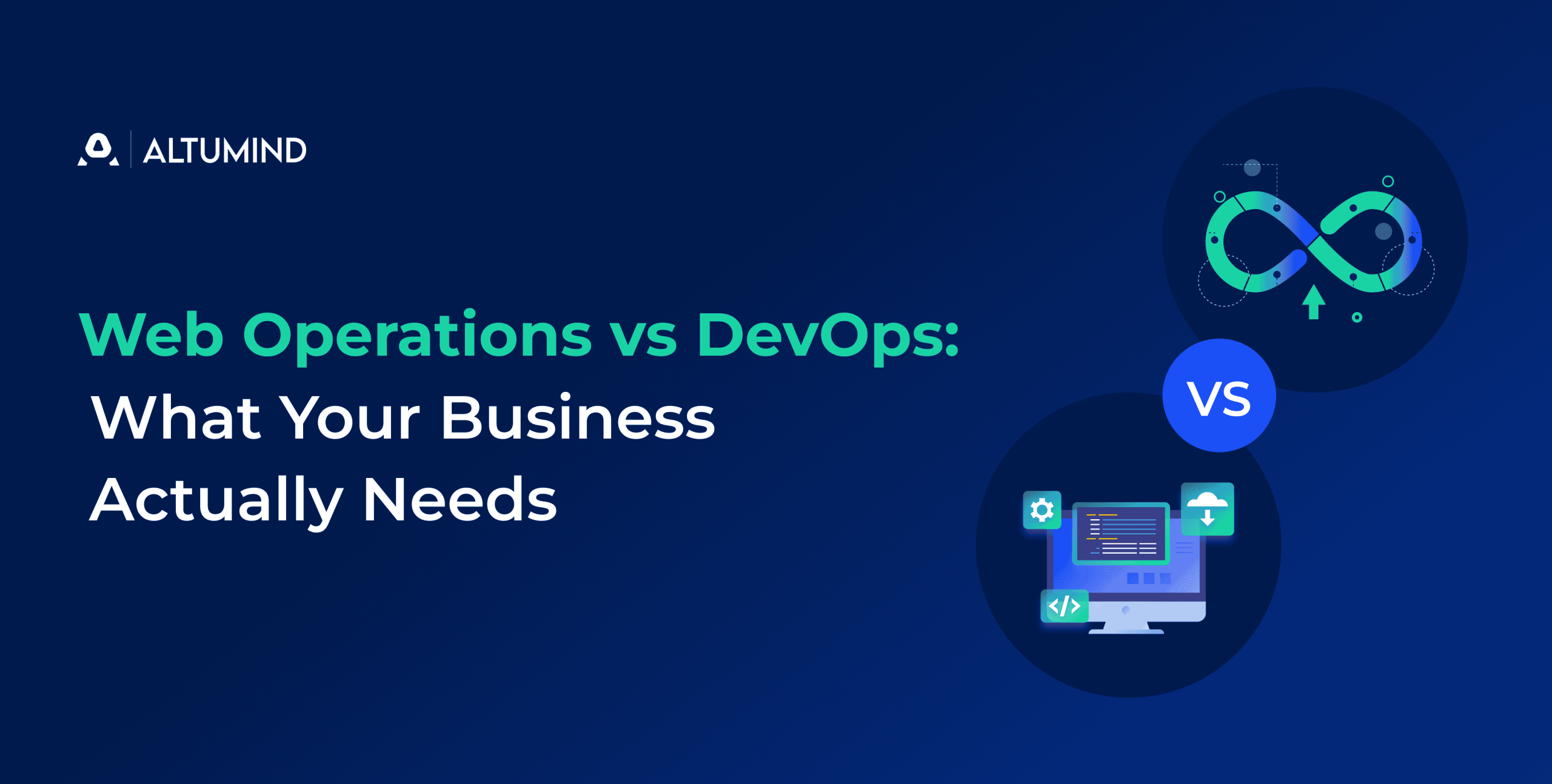Your web application is more than a launch milestone, t’s a 24/7 sales engine. But without the right operational support, even the best-designed site can underperform. That’s where WebOps comes in for keeping your digital storefront secure, fast, and resilient every single day.
WebOps (Web Operations) is the practice of managing the deployment, performance, and maintenance of your web infrastructure proactively resolving issues, improving scalability, and safeguarding the user experience. If your website plays a mission-critical role in customer acquisition, engagement, or revenue, WebOps is the team behind the scenes making sure everything runs flawlessly.
But what exactly are the benefits of WebOps, and how does it compare to DevOps? Let’s explore.
Why Web Operations – Benefits?
Boost SEO and Page Performance
Slow load times and downtime cost not just clicks but also trust. WebOps ensures lightning-fast page loads, high availability, and minimal latency using load balancing, caching, and performance tuning which results in improved search rankings, better UX, and higher engagement.
Strengthen Security and Protect Brand Reputation
From DDoS attacks to data breaches, security threats can cripple your digital presence. WebOps embeds proactive protection with Zero Trust Architecture, real-time threat detection, and encrypted environments keeping your site secure and your brand trusted.
Scale Confidently During Traffic Spikes
Whether you’re running a product launch or a holiday campaign, WebOps ensures your site adapts in real-time. With elastic cloud infrastructure and API-driven flexibility, WebOps enables dynamic scaling without performance bottlenecks or costly outages.
Deliver a Consistent, High-Quality User Experience
Your website must perform flawlessly across devices and geographies. WebOps enhances cross-device performance, eliminates friction, and ensures always-on availability resulting in higher retention, satisfaction, and conversions.
Get Data-Driven Operational Intelligence
The WebOps team leverages analytics and key metrics to make informed decisions on performance optimization and UX improvement areas of your Web Development & Consulting. No more guesstimates! The web operations team will slice and dice data to prioritize areas requiring immediate attention. Predictive analytics, real-time monitoring, behavioral analytics, and actionable KPIs tell a better story for a strategic and measured approach.
Resolve Issues Before They Impact Customers
With WebOps, incident management takes a new life. What would’ve been a slow and manual process is expedited for early closures. Automation tools integrate more efficiency into the process. From root cause analysis to disaster recovery and AI-driven diagnostics, every area of your web application gets an “automation” makeover to streamline the workflows.
Lower Total Cost of Ownership (TCO)
Improving resource utilization through WebOps results in substantial cost savings. Streamlining infrastructure and reducing overhead through cloud-based infrastructure (server costs down), automation frameworks, network optimization (CDN), integrated security, and resource optimization minimizes hardware expenditures, provisions computing power, decreases labor expenses, and reduces bandwidth costs to lower the total cost of ownership (TCO).
DevOps: A Synopsis
DevOps is a development-centric framework focused on continuous integration, deployment speed, and system reliability. It brings engineering, QA, and operations teams together to automate, scale, and optimize the software delivery lifecycle.
By leveraging CI/CD pipelines, Infrastructure as Code (IaC), microservices, and observability tools, DevOps reduces time-to-market, drives agility, and enables frequent, stable releases while ensuring operational efficiency.
When to Choose WebOps vs DevOps
Choose WebOps when:
- Your website is mission-critical to customer acquisition and brand experience.
- You need fast page loads, always-on availability, and UX consistency across devices.
- Marketing teams and content editors need agility for campaigns, personalization, and updates.
- You’re focused on SEO, bounce rates, conversion rate optimization, and performance analytics.
- Uptime, frontend performance, and web publishing workflows are your priority.
- Tooling revolves around CMSs, CDNs, analytics, A/B testing, and tools like New Relic or GTmetrix.
It is the best fit for marketing-led digital experiences that demand operational resilience and speed.
Choose DevOps when:
- You’re delivering complex software, backend systems, or microservice-based platforms.
- You need automated, fast, and reliable deployments across staging and production.
- CI/CD pipelines, Infrastructure as Code (IaC), and container orchestration (Docker, Kubernetes) are central to your process.
- Performance metrics such as MTTR, change failure rate, and deployment frequency matter most.
- You require tight collaboration across dev, QA, and ops for frequent code changes and backend scalability.
It is the best fit for engineering-led application delivery and full-stack software development environments.
Core Functions of a WebOps Team
- Website management: Optimize servers, hosting, and deployment environments
- Performance monitoring: Track uptime, load times, and site responsiveness
- Deployment automation: Automate code releases and rollbacks for reliability
- Security Compliance: Manage SSL, firewall rules, and vulnerability patches
- Incident response: Handle site outages, traffic spikes, errors, and emergency fixes
- SEO and analytics: Measure content impact and ensure output aligns with marketing KPIs
- CMS support: Maintain content platforms like WordPress or Drupal
- Cross-team: Work with Dev, Marketing, and QA for smooth releases
Core Functions of a DevOps Team
- CI/CD Pipeline: Design and maintain CI/CD pipelines for fast, stable deployments
- Automation: Automate repetitive tasks in testing, integration, and deployment
- Infrastructure as Code: Use Terraform or CloudFormation to provision and manage infra
- Observability: Track performance using platforms like Prometheus, Grafana, or Datadog
- Security: Embed security checks to catch vulnerabilities early and reduce risks
- Cross-Team: Coordinate efforts across dev, QA, and ops to streamline the SDLC
- Incident Management: Handle outages, perform root cause analysis, and restore services
- Containerization: Use Docker and Kubernetes to package and manage apps efficiently at scale
Wrapping Up: Web Operations
If user-first delivery is on your checklist, you can’t ignore Web Operations (WebOps). Web Operations go beyond keeping websites running. It single-handedly ensures seamless digital experiences and operational agility. Without WebOps, your site goes “kaput,” which translates to lost revenue. A well-orchestrated WebOps strategy addresses your site’s technical challenges to maintain a superior UX.
Forrester Principal Analyst Rani Salehi defines WebOps as really just trying to provide a customer with a better web experience. It has some key advantages for creating really exceptional web ecosystem experiences – CMS Wire
At Altumind, we understand the complexities of modern web applications and the need for proactive operational excellence, scalability, and efficiency. Whether it’s optimizing performance or ensuring airtight security, Altumind’s WebOps solutions keep your digital ecosystem robust and resilient. Ready to elevate your web operations? Partner with us now!


